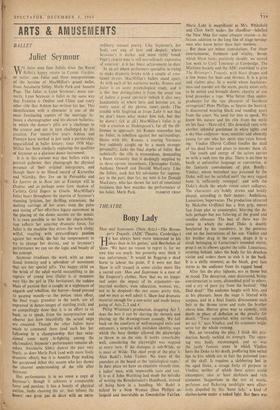ARTS &. AMUSEMENTS
BALLET
Juliet Seymour
WE have seen four Juliets since the Royal Ballet's happy return to Covent Garden; or rather, one Juliet and three interpretations of the heroine of MacMillan's grand ballet, from Antoinette Sibley, Merle Park and Annette Page. The Juliet is Lynn Seymour; more cor- rectly, Lynn Seymour is Juliet in the same way that Fonteyn is Ondine and Chloe and every other role that Ashton has written for her. This identification with a character is one of the most fascinating aspects of the marriage be- tween a choreographer and his chosen ballerina, in which the dancer's gifts. are a challenge to the creator and are in turn challenged by his creation. For twenty-five years Ashton and Fonteyn have worked in just such a partnership, unparalleled in ballet history; since 1958 Mac- Millan has been similarly exploring the qualities of Seymour as a glorious dance instrument.
It is in this curious way that ballets exist as portrait galleries; they photograph the physical presence of their original interpreters, and though there is no filmed record of Karsavina and Nijinsky, they live on in Petrushka and Le Spectre de la Rose just as Fonteyn will in Ondine, and as perhaps some faint shadow of Carlotta Grisi lingers in Giselle. MacMillan's Juliet bears throughout the imprint of Seymour's stunning lyricism, her thrilling extensions, the melting carriage of her arms, even the pulse and timing of her effortless legato movement in the placing of the dance accents on the music. It is even possible to see how the characterisa- tion reflects her amazing dramatic force, for Juliet is the machine that drives the work along; Wilful, reacting with extraordinary passion against her world, she has the temperament to try to change her destiny, and in Seymour's performance we can see the logic and beauty of the concept.
Seymour irradiates the work with an emo- tional intensity and a splendour of movement that are her special gifts. The happy child on the brink of the adult world succumbing to the rapture of young love (Juliet is at moments very like the girl in The Invitation), the sudden blaze of passion that is caught in a nightmare of anguish and rebellion, the horror—hand pressed to gasping mouth—as the potion takes effect, the final tragic grandeur in the tomb, are all expressed in dance-images of startling truth, and sd compellingly done that it is an effort to sit back, so to speak, from the interpretation and observe just how beautifully the actual steps are executed. Though the other Juliets have much to commend them (and each has her following in a championship that has occa- sioned some nasty , in-fighting among the aficionados), Seymour's performance remains ab- solute. Antoinette Sibley dances the part very featly, as does Merle Park (and with more lively dramatic effect), but it is Annette Page making her postponed debut this season who has shown the clearest understanding of the role after Seymour.
Her performance is in no sense a copy of Seymour's, though it achieves a comparable force and passion; it has a beauty of physical outline, limbs cleaving the air, that infuses the lovers' two great pas de deux with an extra-
ordinary sensual poetry. Like Seymour's, her body can sing of love and despair; where Seymour's is darker and more richly toned. Page's clearer note is still marvellously expressive of emotion: it is her finest achievement to date.
In an art where performers specialise in trying to make dramatic bricks with a couple of emo- tional straws, MacMillan's ballets stand apart. As with each of his narrative works, Romeo and Juliet is an acute psychological study, and it is this that distinguishes it from the usual run of ballets a grand spectacle (which it also very handsomely is) where hero and heroine are, in every sense of the phrase, court. cards. (The trouble with Siegfried in Swan Lake is not that we don't know what makes him tick, but that he doesn't tick at all.) MacMillan's Juliet is as rich a creation as Shakespeare's, for all the dif- ference in approach; his Romeo somewhat less so. Juliet, in rebellion against her surroundings, blazes with life; Romeo, a roaring Veronese boy suddenly caught up by a much stronger personality, lacks the final depths of Juliet. But technically the role is tremendous, demanding a fluent virtuosity that is dashingly supplied by its three current incumbents, Christopher Gable, Anthony Dowell and Donald MacLeary. Like the Juliets, each has his advocates for suprem- acy in the part; thus far, my vote is for Donald MacLeary, who has shown the sort of emotional liveliness that best matches the performance of






































 Previous page
Previous page